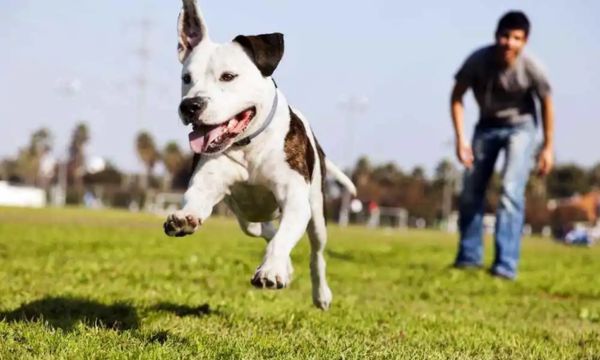The Role of Exercise in Dog Behavior
Exercise is important not only for your dog’s physical health, but also for his or her behavior, mood and overall health. Just as a lack of adequate exercise can lead to a sedentary lifestyle and health problems in humans, dogs also need regular exercise to stay healthy and happy on a mental and emotional level. In this complete guide, we explore the many ways exercise affects canine behavior, including its benefits, its different types, and ways to ensure your canine friend lives a balanced and happy life.
Understanding the Importance of Exercise for Dogs:
The Link between Exercise and Behavior
Dogs are naturally busy animals that have a lot of energy to expend. When dogs don’t get enough exercise, their excess energy can turn into unwanted behaviors. Dogs can show that they have too much energy by barking, digging, chewing or even being mean.
Stimulate and Improve the Mind
Exercise isn’t just good for your body; it’s also good for your mind. Participating in a variety of activities will challenge your dog’s brain so he doesn’t get bored and this is good for his overall mental health.
Why Dogs need Regular Exercise:
1. Good Health
Regular exercise can help dogs maintain a healthy weight, prevent fat-related problems and keep their hearts healthy. It also makes muscles stronger, improves flexibility and makes joints work better.
2. Stimulate the Mind
Exercise keeps your dog’s mind active by exposing him to new places, new smells and tasks. As important as physical activity is in encouraging good behavior, mental activity is just as important.
3. Emotional Health
Endorphins are often referred to as the “feel good” hormones and are released during exercise. These hormones can help dogs reduce stress, anxiety and sadness, making them feel more emotionally balanced.
4. Socialization
Many ways to exercise, such as dog parks and playgroups, are also ways to meet new people. Positive relationships with other dogs and people can help dogs get along with others and reduce their chances of aggressive behavior.
Different Types of Dog Exercises:
1. Aerobic Exercise
Aerobic exercise gets your dog’s heart beating faster, which is good for the heart. Activities such as brisk walking, running, hiking, and swimming are great ways to stay in shape.
2. Play and Interact with Games:
Playing games with your dog, such as fetch, tug of war and hide and seek, can keep him entertained and strengthen the bond between you and your dog.
3. Agility Training
Obstacle training is part of agility training. It ensures that the dog’s body and mind are better coordinated and that he responds better to instructions.
4. Food Vending Machines And Educational Toys
Dogs’ minds are challenged with educational toys and food feeders, where they have to solve problems to get treats or food. This toy prevents dogs from getting bored and makes them work for their food.
5. Obedience Training
Structured obedience training not only teaches your dog commands, it also engages his brain, improving his ability to focus and respond to cues.
6. Dog Sports
Dogs can participate in sports such as agility, flyball, and dock diving, which keep them physically and mentally active.
Tailoring Exercise to Your Dog’s Needs:
1. Consider Age and Breed
Different breeds require different amounts of exercise. Border Collies and other energetic breeds may require more intensive tasks, while smaller or larger dogs may do better at less intensive tasks.
2. Physical Limitations
Dogs with health or physical problems should do what is appropriate for their situation. Talk to your vet to find out what kind of training is best for your dog.
3. Daily Routine
Make sure your dog gets enough exercise every day. To get the most out of exercise, do it regularly.
How Routine and Consistency Help:
1. Make a Schedule
Develop a regular exercise plan for your dog that fits your daily schedule and his or her energy level. This prevents them from getting too angry and taking action.
2. Changes and Improvements
Vary the exercises you and your dog do together. Different tasks test different parts of their body and mind, keeping them interested and excited.
3. Interactive Play
Playing with your dog can strengthen the bond between you. These gatherings help people to trust each other and promote good behavior.
Signs of Proper Exercise:
1.Contentment
Dogs that get enough exercise are generally happier and calmer. They are less likely to show signs of being overly active or anxious.
2. Calm Behavior
Dogs that get enough exercise become calmer, both internally and externally. They are less likely to do things like damage objects or bark excessively.
3. Sleep Patterns
Dogs sleep better when they get the right amount of exercise. Tired dogs sleep better and make less noise at night.
Case Study: How Exercise Changed Max’s Behavior
Meet Max, an Australian Shepherd with a lot of energy that leads him to do bad things. Max’s owner, Sarah, decided to address this problem by putting Max on an extensive exercise regimen.
Sara’s Method
Sarah has developed a complete exercise program for herself, including daily walks, games of fetch and interactive educational toys. She showed Max how to do agility drills, which made him think and act in new ways.
Sarah noticed that Max’s behavior changed significantly over time. He became less angry, more focused and less inclined to do bad things. When Max exercises regularly, his energy is put to good use, making his relationship with Sarah even better.
Conclusion:
There is no doubt that exercise influences dog behavior. You can shape your dog’s behavior in a good and enriching way through regular physical activity, mental stimulation and opportunities to meet new people. Dogs that get enough exercise are more likely to have balanced behavior, less anxiety and better mental health. As responsible dog parents, it’s our job to understand the importance of exercise and how it changes the lives of our canine friends.
FAQs:
1. Can exercise alone completely solve behavioral problems in dogs?
Exercise is an important part of behavior management, but it may not be the only solution. Some behavior problems require professional training and behavior modification techniques.
2. How much exercise does my dog need?
The amount of exercise varies depending on factors such as race, age and individual energy levels. In general, dogs should be given 30 minutes to 2 hours of exercise each day.
3. Is excessive exercise harmful to dogs?
Yes, excessive exercise can lead to injuries and physical strain, especially in puppies and older dogs. It is important to tailor the exercises to your dog’s age, breed and health.
4. Can lack of exercise make dogs aggressive?
Yes, lack of exercise can lead to aggressive behavior. Pent-up energy can lead to depression, which can manifest as aggressive behavior.
5. Can Mental Exercise Replace Physical Exercise in Dogs?
Mental exercise is valuable and necessary, but physical exercise is just as important. Combining mental and physical stimulation provides a comprehensive approach to promoting positive behaviors and overall well-being.
Be sure to check out our article: Enrichment Activities for Behavior Improvement. You’ll be surprised at how it will help you clarify doubts on the subject.
 Stop Destructive Chewing: Solutions
Stop Destructive Chewing: Solutions
Chewing is a natural behavior for dogs. It keeps them aware of their surroundings, keeps their teeth clean and helps them deal with stress or boredom. […]
Keep reading Enrichment Activities for Behavior Improvement
Enrichment Activities for Behavior Improvement
Owning a pet is a rewarding experience, but it’s also your job to meet your furry friend’s behavioral needs. Activities that provide mental and physical stimulation […]
Keep reading Dog Behavior and Nutrition: Vital Connection
Dog Behavior and Nutrition: Vital Connection
The connection between a dog’s behavior and what he eats is an important part of canine health that is often overlooked. As with humans, a dog’s […]
Keep reading